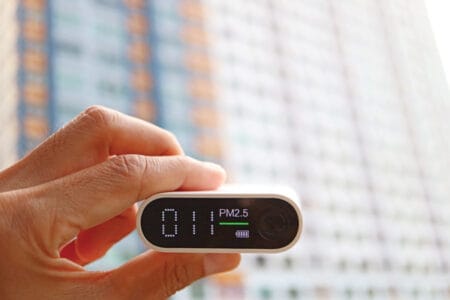By Dr. Serene Almomen
From the December 2023 Issue
With the onset of cold and flu season has come a resurgence of pandemic-era concerns over indoor air quality (IAQ). In particular, cases of respiratory syncytial virus (RSV) are climbing across the United States, with much higher than average infection rates nationwide.¹ As we move further into the winter, it’s imperative that public facilities such as schools, offices, hotel, and commercial real estate buildings implement real-time monitoring to keep occupants safe from airborne viruses this winter.
Though the Environmental Protection Agency (EPA) has designated federal funds for real-time air quality monitors, implementation is taking longer than expected. Meanwhile, airborne contaminants and infections remain alarmingly high and Americans are becoming increasingly concerned.

For example, a report from the U.S. Government Accountability Office found that almost half of U.S. schools are operating with faulty or outdated HVAC systems, and new data shows 8 in 10 parents are very concerned about indoor air quality in their children’s schools. In corporate America, almost half of surveyed office workers are very or extremely worried about their building’s indoor air quality. It’s critical for HVAC systems to be up-to-date, real time monitors or air filters to be installed, and IAQ strategies to be in place to prevent a triple endemic.²
Currently, there is a stark contrast between the state of building health and what is needed to maintain safe air quality. This is especially concerning in public buildings such as schools and commercial real-estate buildings where students, teachers, and employees spend so many hours of their lives each day. The systems that maintain and verify IAQ in the built environment are thus a critical piece of the public health puzzle.
For instance, filtration and air distribution equipment, controls and management practices have often been taken for granted or ignored completely. But increasingly, the public is becoming more aware of the ways that IAQ control strategies can reduce the risk of airborne pathogen transmission, improve cognitive function, and mitigate harmful effects of chemical pollutants and dangerous fine particulates like PM2.5.

These particles can be easily inhaled and lead to a myriad of otherwise-preventable respiratory and cardiovascular health issues, among others. This can lead to rampant absenteeism at both work and school and a reluctance to return to an in-person work schedule. As such, implementing proactive IAQ strategies is the first step to taking charge of air quality before it becomes dangerous.
High-efficiency air filters are designed to capture and stop small particles, including PM2.5 and airborne viruses, by trapping the particles and preventing them from recirculating in the indoor environment. For these filtration systems to be effective, they need proper filter maintenance and filtration upgrades to MERV-13 or higher.
To test the effectiveness of IAQ devices during an air quality event, Boston Properties, the largest publicly traded commercial real estate conglomerate in the U.S., partnered with Attune, an IoT air quality monitoring technology company, to install real-time monitors across more than 40 sites. The data from this case study shows that during this summer’s initial Canadian Wildfire crisis in Boston, New York City, and Washington D.C., IAQ controls effectively removed more than 90% of PM2.5, protecting building occupants from potential PM2.5 health risks.
ESG & HVAC: Improving K-12 Schools
Facility managers at K-12 schools can create a better indoor experience through system efficiency and clean air. Read more…
Today, when the threat of a triple endemic looms large, IAQ monitoring will be essential for measuring and understanding air filtration and distribution system effectiveness in buildings with outdated infrastructure.
Even when there isn’t a full-blown air quality crisis like we saw this summer, indoor air quality is a cornerstone of public health. And the only way to ensure occupant safety is to have proactive IAQ management strategies in place when the air quality event occurs. Actively monitoring data is the only way to know when action is needed to thwart air quality threats.
Until this becomes the universal standard, students, hotel guests, office workers, and everyone who spends the majority of their time inside, will continue to be at risk.
References
¹ abcnews.go.com/Health/cdc-warns-rsv-cases-rising-young-children-southeastern/story?id=102994557
² www.cbsnews.com/
 Almomen, PhD, is the co-founder and CEO of Attune, a sensor-based technology platform. The company provides real-time assurance into critical areas such as indoor air quality, energy consumption, risk of water leaks, critical equipment status, and more.
Almomen, PhD, is the co-founder and CEO of Attune, a sensor-based technology platform. The company provides real-time assurance into critical areas such as indoor air quality, energy consumption, risk of water leaks, critical equipment status, and more.
Do you have a comment? Share your thoughts in the Comments section below, or send an e-mail to the Editor at jen@groupc.com.

















 ESG & HVAC: Improving K-12 Schools
ESG & HVAC: Improving K-12 Schools



![[VIDEO] Collect Asset Data at the Speed of Walking a Building](https://facilityexecutive.com/wp-content/uploads/2024/02/maxresdefault-324x160.jpg)